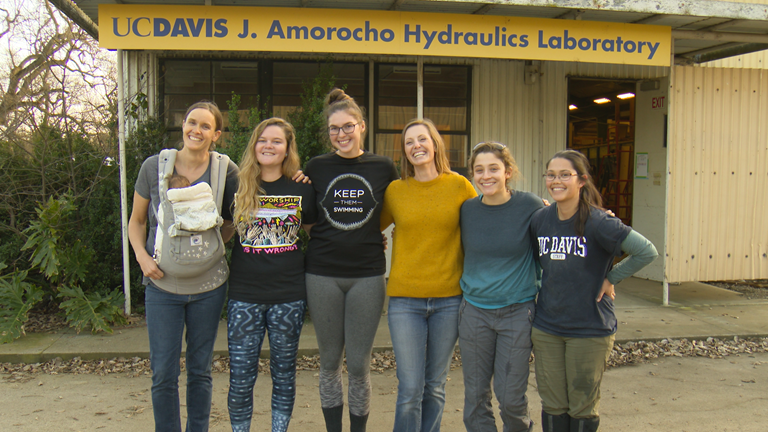DWR Partnership with UC Davis Helps Break Glass Ceiling for Women in STEM
Team of scientists and engineers at the UC Davis J. Amorocho Hydraulics Laboratory. DWR/2020 
The Department of Water Resources (DWR) has partnered with the UC Davis J. Amorocho Hydraulics Laboratory (JAHL) in Yolo County to find innovative ways to investigate fish protection technology within California’s Sacramento-San Joaquin Delta estuary. Originally built as a hydraulics lab to perform modeling studies for the State Water Project (SWP), JAHL has been a DWR tool for maintaining and protecting the State’s water supply for more than half a century.
At the helm of the JAHL, is a team of scientists and engineers who are setting the bar for opportunities made possible by state and regional partnerships, all while inspiring the next generation to pursue careers in Science, Technology, Engineering, and Mathematics (STEM).
“The partnership between DWR and UC Davis is a prime example of DWR’s commitment to establishing dialogue among diverse community groups to improve water resilience and job opportunities,” said Cindy Messer, DWR chief deputy director. “It’s just one of the ways we are working with local and regional water leaders to maintain and restore California’s water supply.”
“The partnership with DWR allows us to keep learning,” said Dr. Kara Carr, the JAHL Lead Engineer. "Collaboration means work for us here and now, so we can pave the way and lay the foundation for our future scientists and engineers."
The JAHL joint-venture has played an essential role in creating job opportunities, particularly for women in STEM disciplines. This is especially important considering that just one-third of all female students choose STEM-related fields in higher education, according to the United Nations Scientific Education and Cultural Organization.
“The partnership with DWR allowed me, and many women after me, to advance in the field,” said Dr. Carr. “When it comes to women in STEM, we’ve been pushing and pushing, and these are the results. Women are the majority here.”
Dr. Carr and her team of researchers, engineers, and biologists are currently working on a $3.1 million project studying the behaviors and swimming patterns of juvenile green sturgeon. Green sturgeon, a threatened fish species native to the Delta, have been disappearing from California waterways in record numbers in recent decades. Dr. Carr and her team have been working on the study since 2015 to find out why.
The study, funded by DWR, aims to improve the survival rates of juvenile green sturgeon by gaining a deeper understanding of the impacts on the species including water diversions and predation by other fish in the Delta.
“Every native species has inherent value,” said Sarah Baird, a JAHL researcher. “In supportive environments, green sturgeon can live close to 100-years, grow more than six-feet in length and weigh upwards of 300-pounds. Right now, they’re listed as threatened species, and we’re hopeful this study will help us find out why.”
Working diligently to protect Delta’s green sturgeon, the JAHL team’s research continues to not only inform the science that integrates modern conservation strategy and infrastructure design, but also creates opportunities for women in STEM to make innovative contributions as stewards of our watersheds.
